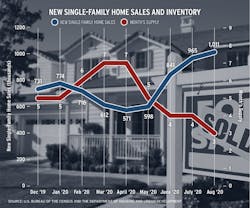Residential construction is going strong—a beacon of hope for a nation looking for a bright spot amid the COVID-19 pandemic. Several key economic factors explain why the home building industry is so robust.
- Interest rates are low
- The federal funds rate is effectively at zero, and the Federal Reserve has indicated that rates could stay low for years
- Pent-up demand is driving strong buyer traffic
- The pandemic is bringing a renewed sense about the importance of home.
A broad range of economic indicators demonstrate that residential construction is, indeed, firing on all cylinders. A few key examples:
- Sales of newly built single-family homes in August topped the 1 million mark and reached their highest pace since September 2006. Sales increased 4.8% to a seasonally adjusted annual rate of 1.01 million units, according to data from the U.S. Department of Housing and Urban Development and the U.S. Census Bureau. The August rate was 43.2% higher than the August 2019 pace.
- Single-family starts in August increased 4.1% to a 1.02 million seasonally adjusted annual rate. The pace of single-family starts is the highest production rate since February.
- The NAHB/Wells Fargo Housing Market Index (HMI), a closely watched measure of builder confidence in the market for newly built single-family homes, reached the highest reading, up five points to 83, in its 35-year history in September.
Home builders still face significant challenges. Record-high lumber prices and a shortage of skilled labor make building homes on time and on budget more difficult. But overall, the housing market is the strongest it has been in almost 15 years.
Residential construction is poised to help lead the nation’s economy back to full strength.
New Single-Family Home Sales Data
Data from the U.S. Bureau of the Census and the Department of Housing and Urban Development puts new-home sales in August at an annual pace of 1.01 million, seasonally adjusted. That’s a gain of approximately 4.8% over the revised July rate of 965,000.
More telling, it is 43.2% above the estimated rate of 706,000 in August 2019. This is the strongest seasonally adjusted annual rate since September 2006. Also telling, sales-adjusted inventory levels continue to decline, falling to a 3.3 months’ supply in August, the lowest in the history of the data series, which dates back to 1963.
Sales are increasingly coming from homes that have not started construction, with that count up 69% year over year, not seasonally adjusted (NSA). In contrast, inventory of for-sale, completed, ready-to-occupy homes is down almost 33% year over year NSA. The low inventory of completed homes available for sale points to continued strength for single-family construction.
ABOUT NAHB: The National Association of Home Builders is a Washington, D.C.-based trade association representing more than 140,000 members involved in home building, remodeling, multifamily construction, property management, subcontracting, design, housing finance, building product manufacturing, and other aspects of residential and light commercial construction. For more, visit nahb.org.

